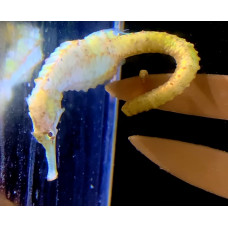Latin name
Hippocampus trimaculatus
Other name
Longnose seahorse, low-crowned seahorse, three-spot seahorse.
Identification
The appearance of the flat-faced seahorse can vary, but it is usually flat with sharp, hook-like cheek and eye protrusions, a narrow head, and no nasal protrusions.
Features of fish fins
Dorsal spines (total): 0; Dorsal soft rays (total): 18 - 22; Anal spines: 0; Anal soft rays: 4.
Fish colouring
The coloration can be golden-orange, sand-colored, or even completely black. Some have been known to have brown and white stripes like a zebra.
Distribution
Widespread in the shallow waters of the Indo-West Pacific: from India to Tahiti; north to Japan, south to Indonesia.
Habitat
These seahorses typically inhabit areas such as gravel or sandy bottoms around coral reefs, in muddy estuaries and near mangroves, and they can also inhabit brackish waters.
Size
Males are slightly longer on average than females. Their maximum length is 22 cm.
Behavior
Recently, juveniles have been seen at depths of less than 0.1 meters, and these may have been the first drifting juvenile seahorses ever recorded in the Strait of Malacca, providing strong evidence for the long-distance passive migration of this species.
Food and feeding habits
Its diet consists of plankton and small crustaceans that it sucks up with its snout. This species likes to cling to seagrass while feeding to conserve energy, which is typical seahorse behavior.
Reproduction
In this species, maturity is better defined by size than age. For example, populations in the South China Sea and North China Sea reached the same size, but those found in the South China Sea were 3 months old and those found in the North China Sea were 5 months old. These seahorses reach sexual maturity before they reach 10 centimeters in length, unlike some other seahorse species that reach maturity when they are over 10 centimeters in length.
When flat-faced seahorses mate, the females give their eggs to the males, who incubate them and give birth to live young. The gestation period ranges from 11 to 20 days, with an average of 16 days - this difference seems to depend on water temperature. The gestation period for this species was 19 days at 22.5°C, 16 days at 24°C, and 11 days at 28.5°C, which is consistent with other members of the genus Hippocampus. In captivity, they breed throughout the year. In the China Sea, they reach their peak breeding season from March to May. Their peak breeding season may vary from place to place as they breed depending on the consistency of the water temperature.
Fishing
They are often subject to bycatch.
Relationship with a person
Flat-faced seahorses are often collected and used in traditional Chinese medicine; they are commonly dried and sold as souvenirs in the United States and as pets around the world.
| Classification | |
| Phylum | Chordata |
| Class | Actinopterygii |
| Squad | Syngnathiformes |
| Family | Syngnathidae |
| Genus | Hippocampus |
| Species | H. trimaculatus |
| Features | |
| Conservation status | Vulnerable |
| Habitat | Pelagic |
| Life span, years | No information |
| Maximum body weight, kg | No information |
| Maximum length, cm | 22 |
| Sailing speed, m/s | No information |
| Threat to people | Not edible |
| Way of eating | Planktonophage |
Flat-faced seahorse
Tags: flat faced seahorse



